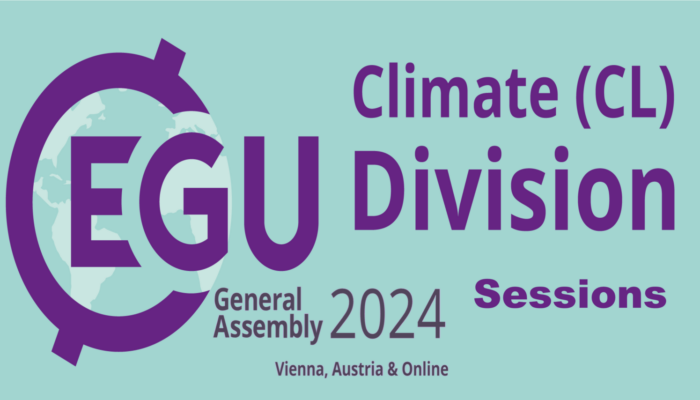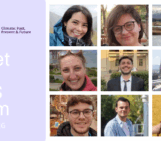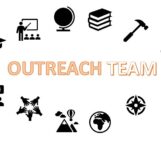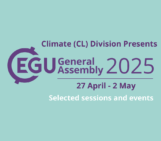
Dear community of climate enthusiasts and EGU lovers,
We know that being part of the EGU is not just about staying in the loop with the latest geoscience works – especially when it comes to our all-time favorite realm of sciences: climate sciences 🤩. It is also an amazing opportunity to spark exciting collaborations and expand your network with scientists from all over Europe and the world. EGU is more than a congress; it is a dynamic community fueled by research passion and connections with like-minded enthusiasts. EGU’s general assembly is a place where knowledge meets fellowship, making the whole experience even more rewarding and enriching. Here is to the EGU and the amazing connections it brings our way!
Now that we have set the stage, we warmly invite you to register and be part of the upcoming General Assembly the next April 14–19, 2024, either at our familiar venue or online. As part of the Climate Division, we are thrilled to invite you to attend our exciting sessions covering the past, present, and future of climate!– some of them are led by our incredible early-career scientists, who truly have a special place in our hearts! Acknowledging the dedication it takes to organize and pull off a session at EGU as an ECS, this time, we are turning the spotlight on the diverse sessions planned by our beloved young climate researchers. Let’s dive deep into them!
CL0 – Inter- and Transdisciplinary Sessions
Embark with us into a collective journey of inter and transdisciplinary works in climate science. To begin with, Emanuele Bevacqua will guide us through the complexities of compound weather and climate events, unraveling their interconnected nature. Join the discussion if you want to know more about how often novel compound events will emerge in the future. Keeping the debate on the future, Lina Teckentrup addresses the critical issues of climate forcing and uncertainties within the CMIP framework, offering key insights and future directions. On the other hand, we know that the uncertain climate future may have devastating consequences for our society. For this reason, Sourangsu Chowdhury’s PICO session delves into the profound intersection of climate, extremes, and health: mapping risks and quantifying impacts on population health. If instead, you want to know how evolution and the complex climate-ecology interactions have played out in the past, join Thushara Venugopal in the session: Forensics of Climate and Life, to shed light on the fingerprints left by climate on various aspects of our ecosystems. But wait, there is more: Kai Kornhube steers the discussion towards practical applications, focusing on advances in physical climate risk assessment for the financial and insurance sectors. Finally, to conclude and switch the topic up, If you think climate modeling cannot get any better, Jack Atkinson invites us to deepen the advantages of enriching numerical modeling with machine learning by exploring challenges, successes, and lessons learned.
CL1 – Past Climate
Looking back into deep time helps us to better understand our present and future climate. But how well do we really know our climatic past? To dig up some answers, let’s get immersed in our quaternary sessions. To those “proxy lovers”, dive deep into the interdisciplinary wonders of tree-ring research, led by Elisabet Martinez-Sancho, while Sophie Warken will guide us through the depths of speleothem and karst records in unraveling terrestrial climatic tales. If you are wondering if the current anthropogenic climate change can push the climate system over similar tipping points than those triggered by the abrupt climate fluctuations during the last glacial period, then join the debate with Irene Malmierca Vallet at her session Dansgaard–Oeschger events: Past tipping events. Moving along cold poles: Henrieka Detlef steers the focus towards the Arctic and Antarctic, bridging the geological past to future predictions. On the other hand, Elisa Ziegler takes us on a journey through paleoclimate modeling, unraveling the threads of time from sensitivity experiments to future simulations. Finally, join Nils Weitzel to explore the interactions between vegetation, wildfire, and climate during the Quaternary, weaving insights from both data and models.
CL2 – Present Climate
Continuing our vibrant sessions, we jump from proxies to observations, from the past to the present. The climate system is fully interconnected, not only by its subsystems but spatially. In fact, multiple weather phenomena are happening at different locations on Earth that are linked, we call these: teleconnections. If you are interested in the most famous one driving variability in Earth’s climate, join Nicola Maher in the depths of ENSO and Tropical Basins Interactions to get up into the dynamics and predictability of the phenomenon. If your thing is the unexpected and the worst-case scenarios, you cannot miss the Timo Kelder session on high-impact climate events and storylines: from physical understanding to impacts and solutions. Last but not least, the urban jungle takes center stage with Daniel Fenner and his session on urban climate, urban biometeorology, and science tools for cities. If you are wondering how cities use novel science to facilitate policies to face climate change, this is undoubtedly your session!
CL3 – Future Climate
Now that we know more about how the climate of the past has evolved, and how our present behaves, it is time to find out what the future holds: what are we facing? With the ongoing climate change, climate scientists channel their efforts into understanding what mechanisms are driving this global change. Questions abound: To what extent does human influence play a role? How much is attributed to internal variability? This is precisely the focus of the Sabine Undorf session, which aimed at attributing climate change and extreme events, by unraveling quantifiable contributions from external forcing, internal climate variability, and other drivers. On the other hand, if you are curious about how to modify Earth’s radiation budget to reduce the anthropogenic footprint of carbon, get into Matthew Henry’s session on solar radiation modification, clouds, aerosols, and join the debate on their ecological impacts.
CL4 – Climate studies across timescales
Diving right back into our Earth’s climate-interconnected system, let’s explore teleconnections and evolving synoptic systems with Rohit Ghosh by unveiling the dynamics of regional climate variability and change. If you are a quaternary lover, plunge with Martina Hollstein into the ocean and climate variability of the low-latitude Indo-Pacific Ocean during the last ~2.6 Ma. Moving along the interaction between small and large-scale processes, if you are interested in knowing how sub-grid scale processes shape the climate system, stay tuned to Hans Segura and the session on earth system models at km-scale and beyond. Not forgetting the Kunhui Ye session on climate and weather extremes in a warming climate, if your things are climate extremes and you are willing to join a 3P (Processes, Prediction, and Projection) framework to forge scientific consensus and influence policymakers to move to better policies to address climate adaptation, keep this session in your radar.
CL5 – Tools for Climate studies
Our division is also holding a bunch of sessions on tools used in climate research, providing an in-depth exploration into the up-to-date methods and instruments driving our understanding of the climate. This time is the turn to highlight Lorenzo Minola’s PICO session on climate data homogenization and analysis of climate variability, trends and extremes. Big fans of observational data and rescuers of centennial records: be sure to stay in the loop about this session!
In wrapping up, the diverse sessions spearheaded by our young researchers offer just a glimpse of the efforts in climate sciences to decipher the intricate Earth’s climate system across various temporal and spatial scales. From novel proxy and historical-based climate reconstructions to cutting-edge tools and techniques, each session adds a piece to the puzzle of the climate system as a whole, helping us better comprehend the present and forecast the future. And, of course, we acknowledge enough the great contribution of our outstanding early career researchers in fostering engaging debates within the EGU community through these captivating sessions. The roadmap of #EGU24 is now laid out!—whether in person in Vienna or virtually online—let’s embark on this exciting journey together and we would be thrilled to have a chat with you! 😀
This blog was edited by the CL editorial board.



